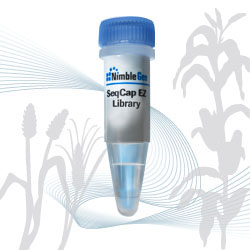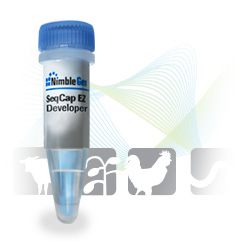Identifying and targeting specific genomic regions of interest are important to advancing our insights into biological systems. The Roche NimbleGen SeqCap EZ technology is a revolutionary process for the enrichment of selected genomic regions from full complexity human genomic DNA in a single step. Sequence capture eliminates the need for designing and performing thousands of parallel PCR reactions. SeqCap EZ enrichment is also a cost-effective alternative compared to whole-genome sequencing. Specific multi-kilobase genomic regions, exomes or panels of genes can all be targeted based on researchers needs.
Using this approach the focus has been studying disease and the underlying mutations present in the genome. Currently SNPs or small in/dels in the targeted exonic regions can be identified as the main readout from sequencing short fragments. By increasing the length of the captured fragments using the same designs and reagents, the SeqCap EZ technology can be expanded to enrich for regions surrounding the existing probes. Instead of targeting a 200 bp region around a probe, several kilobases can be captured. Thus, mutations in introns that may lead to splice variants and larger in/dels may be detected. When partnered with a long-read sequencing technology, the context of these additional events can be phased and accurate haplotypes can be identified.
During the webinar, the presenters will describe a targeted sequencing workflow that combines Roche NimbleGen’s SeqCap EZ enrichment technology with Pacific Biosciences’ SMRT® Sequencing to provide a more comprehensive view of variants and haplotype information over multi-kilobase, contiguous regions. They will demonstrate that 6 kb fragments can also be utilized to enrich for long fragments that extend beyond the targeted capture site and well into (and often across) the adjacent intronic regions. When combined with SMRT Sequencing, multi-kilobase genomic regions can be phased and variants, including complex structural variants (1), can be detected in exons, introns and intergenic regions. In one example, Chaisson et. al. determined >97% of structural variants were 5 kb or less and the majority had not been previously reported.
Using SeqCap EZ Designs Cancer and MHC panels to demonstrate the approach, it was determined that on average >60% of the reads were on target and the average enrichment was 1300X. For the MHC region, the enrichment was largely contiguous over the 5 Mb region. For example, HLA-DQA1, a 6.5 kb gene, had even coverage and with the use of SAMtools the reads were phased and haplotypes generated. These results were confirmed to by two other methods. HLA primers from GenDx were used to generate amplicons which and the amplicons were sequenced by Sanger and SMRT Sequencing. The results were 100% concordant among the three methods.
Long contiguous regions were evenly covered using the Cancer panel of 578 cancer-associated genes. In fact, we will present a 35-kb region of the KMT2D gene which was covered in its entirety. Analysis of a portion of the BRCA1 gene yielded fifteen SNPs of which eight were not identified by short-read sequencing technology. Additionally, utilizing these BRCA1 SNPs, the long reads were phased and were grouped by haplotype.
Wang et al (2) confirmed the utility of the combined SeqCap EZ technology and SMRT Sequencing. They stated, “The new method leverages the cost efficiency of targeted capture-sequencing as well as the mappability and scaffolding capabilities of long sequencing reads generated by the PacBio® platform. It is therefore suitable for studying complex SVs, especially those involving LCRs, inversions, and the generation of chimeric Alu elements at the breakpoints.”
Targeted sequencing of 6 kb fragments using Roche NimbleGen’s SeqCap EZ enrichment combined with SMRT Sequencing provides even coverage over multi-kilobase regions of the genome. With PacBio long reads, heterozygous SNPs can be used to phase the reads and generate accurate haplotypes. This method provides a more comprehensive view of the targeted regions of interest. Capture probe sets for whole exomes or specific applications, as well as custom designs can be ordered from Roche NimbleGen.
References:
1) Chaisson et al. Resolving the complexity of the human genome using single-molecule sequencing, Nature (2014)
2) Wang et al., PacBio-LITS: a large-insert targeted sequencing method for characterization of human disease associated chromosomal structural variations BMC Genomics (2015)
Speakers

Dr. Lawrence Hon, Senior Manager, Bioinformatics, Pacific Biosciences
Lawrence Hon is a bioinformatics manager at Pacific Biosciences with broad experience in bioinformatics analysis, algorithm development, and software design. He works with customers to help them understand PacBio data, design experiments, and analyze their data, with an eye towards developing new methods and applications. He received his undergraduate degree in computer science from Stanford University, and a bioinformatics PhD from University of California at San Francisco where he studied transcription factor binding site modeling. He then did an industry postdoc at Genentech, research of which included studying microRNA behavior by intersecting gene and miRNA expression data. Before PacBio, he worked at 23andMe developing a Relative Finder feature that connects distant relatives using identity-by-descent estimated from SNP microarray data.

Dr. Denise Raterman, R&D Scientist, Sequence Capture, Roche NimbleGen
Denise Raterman is a Scientist at Roche NimbleGen with experience leading protocol and product development for sequence capture. She received her undergraduate degree at the University of Wisconsin – Madison with a double major in Wildlife Ecology and Genetics. She earned her PhD in Evolution, Ecology and Organismal Biology at the University of California – Riverside, studying the molecular evolution of mammalian fertilization genes. With extensive research experience, Denise joined Roche NimbleGen after obtaining her Ph.D. Denise led the development of the long fragment target enrichment protocol using the Roche NimbleGen SeqCap technology, and currently leads the continued development of this and other next-generation targeted enrichment technologies.
Who Should Attend?
Genetics and genomics researchers, principle investigators, laboratory scientists, genome center directors, clinical and translational researchers, cancer/oncology researchers, agricultural genetic researchers
Xtalks Partner
Roche NimbleGen
Roche NimbleGen is an innovator in the life sciences market focused on research activities and manufacturing target enrichment probe pools for DNA sequencing. Capitalizing on the efficiencies inherent with parallel enrichment, researchers can now design economical, high throughput, and time-saving next-generation sequencing experiments. Next-generation sequencing combined with Sequence Capture probe pools offers researchers a clearer understanding of genomic structure and function in order to understand the impact of genes on biological processes. We are part of the innovations in sequencing solutions for life science research, now and in the future.
Media Partner
You Must Login To Register for this Free Webinar
Already have an account? LOGIN HERE. If you don’t have an account you need to create a free account.
Create Account





